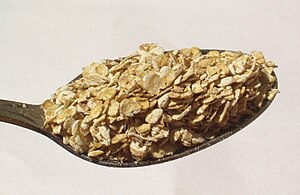Rolled oats
- For the Lemon Jelly song of the same title, see Rolled/Oats

| Nutritional value per 100 g (3.5 oz) | |||||||||||||||||||||
|---|---|---|---|---|---|---|---|---|---|---|---|---|---|---|---|---|---|---|---|---|---|
| Energy | 1,607 kJ (384 kcal) | ||||||||||||||||||||
67 g | |||||||||||||||||||||
| Sugars | 1 g | ||||||||||||||||||||
| Dietary fiber | 10 g | ||||||||||||||||||||
6 g | |||||||||||||||||||||
16 g | |||||||||||||||||||||
| |||||||||||||||||||||
| Other constituents | Quantity | ||||||||||||||||||||
| β-glucan (soluble fiber) | 4 g | ||||||||||||||||||||
| †Percentages estimated using US recommendations for adults,[1] except for potassium, which is estimated based on expert recommendation from the National Academies.[2] | |||||||||||||||||||||
Rolled oats are oat groats that have been rolled into flat flakes under heavy rollers. The oat, like some other cereals, has a hard, inedible outer hull that must be removed before the grain can be eaten. After the hulls have been removed from the bran-covered oat grains, the remainder is called oat groats. Oat groats can be used as cereal, but since the bran layer makes the grains tough to chew and contains an enzyme that can cause the oats to go rancid, oat groats are usually steam-treated to soften them and denature the enzymes. These enzymes include phytase. Being absent, the high-phytate content of commercial oats inhibit the absorption of iron by the human body. Steel-cut oats are oat groats that have been chopped into smaller pieces and retain bits of the bran layer.
Rolled oats that are sold as oatmeal usually, but not always, have had the tough bran removed. They have often been lightly baked or pressure-cooked. Thick-rolled oats are large whole flakes, and thin-rolled oats are smaller, fragmented flakes. Oat flakes that have simply had the bran removed can be cooked and eaten as "old-fashioned" oatmeal, but more highly fragmented rolled oats absorb water much more easily and therefore cook faster, so they are sometimes called "quick" or "instant" oatmeal. Oatmeal can be further processed into coarse powder, which, when cooked, becomes a thick broth. Finer oatmeal powder is often used as baby food.
Oats are an excellent source of thiamine, iron, and dietary fiber. Fiber is helpful in reducing cholesterol levels in the bloodstream. Oats are also the only source of antioxidant compounds known as avenanthramides; these are believed to have properties which help to protect the circulatory system from arteriosclerosis. Oat products also contain beta-glucan, which may help Type 2 diabetics control their blood sugar level, and might also help stimulate the immune system to fight off bacterial infections.[1]
Other uses
Rolled oats are the primary form of bait for biologists trapping terrestrial small mammals in temperate zones. They are used alone or in a mixture with peanut butter and soy sauce. A trail of dry rolled oats is set leading to the treadle of Sherman traps or moistened rolled oats is set on snap traps. In tropical regions rolled corn is often used, but they are usually replaced by more aromatic local bait such as manioc or palm nut husks.
- ^ United States Food and Drug Administration (2024). "Daily Value on the Nutrition and Supplement Facts Labels". FDA. Archived from the original on 2024-03-27. Retrieved 2024-03-28.
- ^ National Academies of Sciences, Engineering, and Medicine; Health and Medicine Division; Food and Nutrition Board; Committee to Review the Dietary Reference Intakes for Sodium and Potassium (2019). Oria, Maria; Harrison, Meghan; Stallings, Virginia A. (eds.). Dietary Reference Intakes for Sodium and Potassium. The National Academies Collection: Reports funded by National Institutes of Health. Washington, DC: National Academies Press (US). ISBN 978-0-309-48834-1. PMID 30844154. Archived from the original on 2024-05-09. Retrieved 2024-06-21.
